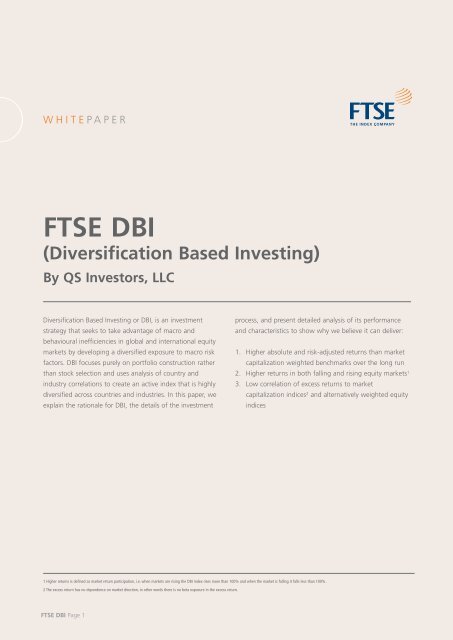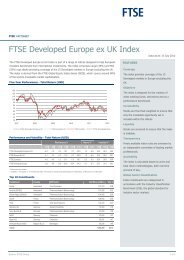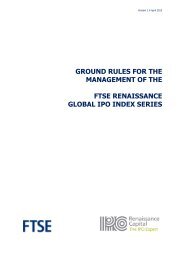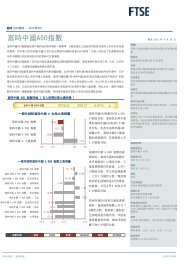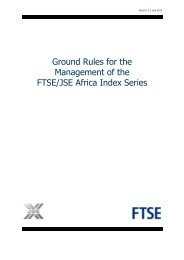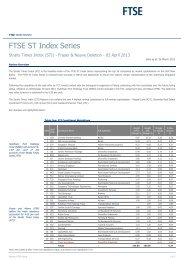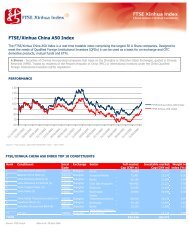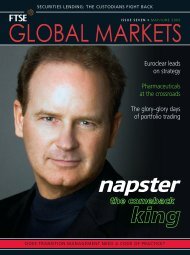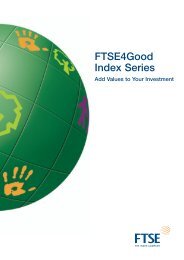QS Investors Diversification Based Investing Whitepaper - FTSE
QS Investors Diversification Based Investing Whitepaper - FTSE
QS Investors Diversification Based Investing Whitepaper - FTSE
You also want an ePaper? Increase the reach of your titles
YUMPU automatically turns print PDFs into web optimized ePapers that Google loves.
W H I T E P A P E R<br />
<strong>FTSE</strong> DBI<br />
(<strong>Diversification</strong> <strong>Based</strong> <strong>Investing</strong>)<br />
By <strong>QS</strong> <strong>Investors</strong>, LLC<br />
<strong>Diversification</strong> <strong>Based</strong> <strong>Investing</strong> or DBI, is an investment<br />
strategy that seeks to take advantage of macro and<br />
behavioural inefficiencies in global and international equity<br />
markets by developing a diversified exposure to macro risk<br />
factors. DBI focuses purely on portfolio construction rather<br />
than stock selection and uses analysis of country and<br />
industry correlations to create an active index that is highly<br />
diversified across countries and industries. In this paper, we<br />
explain the rationale for DBI, the details of the investment<br />
process, and present detailed analysis of its performance<br />
and characteristics to show why we believe it can deliver:<br />
1. Higher absolute and risk-adjusted returns than market<br />
capitalization weighted benchmarks over the long run<br />
2. Higher returns in both falling and rising equity markets1 3. Low correlation of excess returns to market<br />
capitalization indices2 and alternatively weighted equity<br />
indices<br />
1 Higher returns is defined as market return participation, i.e. when markets are rising the DBI index rises more than 100% and when the market is falling it falls less than 100% .<br />
2 The excess return has no dependence on market direction, in other words there is no beta exposure in the excess return.<br />
<strong>FTSE</strong> DBI Page 1
Introduction<br />
Over ten years ago, <strong>QS</strong> <strong>Investors</strong> developed the<br />
<strong>Diversification</strong> <strong>Based</strong> <strong>Investing</strong> (DBI) strategy to try to<br />
take advantage of macro inefficiencies in equity<br />
markets by developing a portfolio construction<br />
process with a greater degree of diversified exposure<br />
to macro risk factors. Through analysis of country and<br />
industry correlations, DBI creates a portfolio that is<br />
highly diversified across these factors and can create<br />
higher absolute and risk-adjusted returns than market<br />
capitalization indices with less downside risk.<br />
DBI is based on three key beliefs:<br />
1. Geography and industry are the primary drivers of<br />
global equity risk<br />
2. Market sentiment generates momentum effects in<br />
indices, which leads to concentration risk that<br />
builds and collapses<br />
3. A diversified portfolio helps to avoid concentration<br />
risk and reduces downside market participation<br />
Recent academic and practitioner research lends<br />
support to these beliefs by pointing out that a large<br />
part of returns in international equity markets are<br />
driven by macro effects: the business a company is in<br />
(industry) and where the business is located<br />
(geography).<br />
Jung and Shiller have asserted that markets show<br />
macro-inefficiency “in the sense that there are long<br />
waves in the time series of aggregate indexes of<br />
security prices below and above various definitions of<br />
fundamental values.” 3<br />
<strong>FTSE</strong> DBI Page 3<br />
However, most active equity managers focus on stock<br />
selection to beat their benchmarks despite the<br />
argument from academic research that equity<br />
markets show considerable micro efficiency, 4 that is<br />
that individual security mispricings tend to be wiped<br />
out fairly quickly.<br />
This suggests broader investment opportunities may<br />
exist to add value at the macro level through portfolio<br />
construction rather than stock selection. DBI’s unique<br />
portfolio construction process takes advantage of<br />
these findings and has consistently added value,<br />
delivering:<br />
1. Higher absolute and risk-adjusted returns than<br />
their respective indices<br />
2. Outperformance in both up and down markets<br />
3. Low correlation of excess return to both their<br />
respective indices and stock selection based<br />
alternative equity index approaches<br />
For the 10 years ending December 31, 2010, the<br />
<strong>FTSE</strong> DBI Indices have outperformed their respective<br />
market capitalization benchmarks with a high level of<br />
consistency as measured by the information ratio.<br />
10 Year (%pa) 10 Year Information Ratio 5<br />
<strong>FTSE</strong> DBI Developed Index 6.52 0.80<br />
<strong>FTSE</strong> Developed Index 3.02<br />
<strong>FTSE</strong> DBI Developed ex Japan Index 6.75 0.81<br />
<strong>FTSE</strong> Developed ex Japan Index 3.23<br />
<strong>FTSE</strong> DBI Developed ex US Index 8.43 1.36<br />
<strong>FTSE</strong> Developed ex US Index 4.83<br />
* <strong>Based</strong> on monthly annualized total returns<br />
SOURCE: <strong>FTSE</strong> Group<br />
3 Samuelson’s dictum and the stock market, Jung and Shiller (2005)<br />
4 Irrational Exuberance, 2nd Ed. (2001), p. 243<br />
5 Information Ratio as a measure of consistency of return measured by the annualized excess return divided by annualized standard deviation of that return
1 | Rationale and philosophy<br />
DBI is based on three key beliefs:<br />
1. Geography and industry are the primary drivers of global<br />
equity risk<br />
2. Market sentiment generates momentum effects in<br />
capitalization-weighted indices, which leads to<br />
concentration risk that builds and collapses<br />
3. A diversified portfolio helps to avoid concentration risk<br />
and reduces downside market participation<br />
The rationale for the first two beliefs is given below. The third<br />
is explained in section three, “Performance analysis”.<br />
Figure 1: The importance of Country, Currency and Industry exposures<br />
Explanatory Power of Gem Factors<br />
Rolling 12-month average<br />
100%<br />
80%<br />
60%<br />
40%<br />
20%<br />
0%<br />
Jan-1995<br />
Jan-1996<br />
<strong>FTSE</strong> DBI Page 4<br />
Jan-1997<br />
Jan-1998<br />
Jan-1999<br />
Jan-2000<br />
Jan-2001<br />
Belief 1 | Geography and industry drive global equity<br />
risk and return<br />
Geography (where a company is located or country and<br />
currency) and Industry (what company a business is in) have<br />
explained more than 90% of the factor risk in global equity<br />
markets over the last 15 years. Other factors such as size,<br />
value/growth, volatility and momentum, have explained less<br />
than 10%. To illustrate this, Figure 1 shows the explanatory<br />
power of BARRA’s Global Equity Market factors highlighting<br />
that over a rolling 12-month basis that the Country, Currency<br />
and Industry factors drive over 90% of the factor risk.<br />
This is why DBI’s investment process focuses on geography<br />
and industry as the key building blocks.<br />
Jan-2002<br />
Jan-2003<br />
Jan-2004<br />
Jan-2005<br />
Jan-2006<br />
Jan-2007<br />
Jan-2008<br />
Jan-2009<br />
Source: BARRA, <strong>QS</strong> <strong>Investors</strong> analysis<br />
Risk Indices<br />
Industries<br />
Currencies<br />
Countries
Belief 2 | Market sentiment leads to concentration risk<br />
that builds and collapses<br />
Broad equity indices are often considered highly diversified<br />
investments. And yet, market sentiment—or, put another<br />
way, investors’ collective enthusiasms—can cause dangerous<br />
concentrations in certain parts of capitalization weighted<br />
indices.<br />
Dec-1993<br />
<strong>FTSE</strong> DBI Page 5<br />
Dec-1995<br />
Dec-1997<br />
Dec-1999<br />
Dec-2001<br />
The <strong>FTSE</strong> World Index is one of many benchmarks to have<br />
experienced concentrations that built up and then collapsed.<br />
Two prime examples—from different decades—involved<br />
Technology stocks and more recently, Financial stocks.<br />
In the mid-to- late 1990s the weight of Technology stocks in<br />
the <strong>FTSE</strong> Developed Index surged from just over 5% to almost<br />
25% (Figure 2).<br />
Figure 2: Index weight of Technology stocks in the <strong>FTSE</strong> Developed Index (December 1993 – August 2010)<br />
% Weight Index<br />
30%<br />
25%<br />
20%<br />
15%<br />
10%<br />
5%<br />
0%<br />
Source: <strong>FTSE</strong> Group, <strong>QS</strong> <strong>Investors</strong> LLC analysis<br />
Dec-2003<br />
Dec-2005<br />
Dec-2007<br />
Dec-2009<br />
Aug-2010
The increased weight reflected a strong enthusiasm for<br />
Technology stocks. But it also generated momentum that<br />
propelled the collective market capitalization of Technology<br />
stocks even higher, as index tracking funds and active<br />
managers bid up the stocks.<br />
More recently, Financial stocks went through large increases<br />
as earnings increased with the advent of financial firms<br />
leveraging the real estate boom, new earnings sources<br />
generated by new financial instruments, investors belief that<br />
business cycles would be more moderate than in the past,<br />
Dec-1993<br />
In our view, these concentrations resulted from consistent and<br />
repeated patterns of investor behavior. Over the long-term,<br />
stock prices will oscillate around the company’s intrinsic value<br />
but be closer to the average intrinsic value. But in the shortterm—and<br />
for more extended periods during bubbles—<br />
market cap-weighted indices often overweight overvalued<br />
stocks as investors become too optimistic about their growth<br />
potential, and underweight undervalued stocks for the<br />
opposite reason. This phenomenon, which has been<br />
documented in the academic literature over the last several<br />
years, 6 is illustrated in Figure 5.<br />
DBI’s investment process is designed to counteract the<br />
concentration risk seen in market capitalization weighted<br />
indices.<br />
6 Financial Analysts Journal (Treynor, 2005), Journal of <strong>Investing</strong> (Hamza, et al, 2007)<br />
<strong>FTSE</strong> DBI Page 6<br />
Dec-1995<br />
Dec-1997<br />
Dec-1999<br />
Dec-2001<br />
and increased risk taking by these institutions. The increase<br />
in earnings led investors to become very excited by the<br />
earnings growth prospects of financial firms and the lower<br />
potential volatility of earnings. This led them to bid up<br />
financial stocks relative to the rest of the market causing the<br />
weight of Financials in the index to increase from a low of<br />
17% in 2000 to a peak of almost 28% of the index in 2006.<br />
Over the next two years the concentration collapsed as<br />
financial stocks fell to nearly half their weight to just over<br />
16% of the index in early 2009 (see Figure 4).<br />
Figure 4: Index weight of Financial stocks in the <strong>FTSE</strong> Developed Index (December 1993 – August 2010)<br />
% Weight Index<br />
30%<br />
25%<br />
20%<br />
15%<br />
Source: <strong>FTSE</strong> Group, <strong>QS</strong> <strong>Investors</strong> LLC analysis<br />
Dec-2003<br />
Dec-2005<br />
Intrinsic value<br />
Dec-2007<br />
Figure 5: Distribution of Stock Price Versus True<br />
“Intrinsic Value”<br />
Undervalued Overvalued<br />
Increasing<br />
underweight<br />
Source: <strong>FTSE</strong> Group, <strong>QS</strong> <strong>Investors</strong> LLC analysis<br />
Increasing<br />
overweight<br />
Dec-2009<br />
Aug-2010
Academic foundations<br />
The conceptual basis for DBI is supported by a growing<br />
body of research. Academics and theorists have recently<br />
argued that although modern markets show considerable<br />
micro efficiency7 —simply put, that individual security<br />
mispricings tend to be wiped out fairly quickly—they are<br />
less efficient at the macro level. Jung and Shiller have<br />
asserted that markets show macro-inefficiency “in the sense<br />
that there are long waves in the time series of aggregate<br />
indices of security prices below and above various<br />
definitions of fundamental values.” 8<br />
Put another way, “because the aggregate averages out the<br />
individual stories of the firms, and the reasons for changes<br />
in the aggregate are more subtle and harder for the<br />
investment public to understand—having to do with<br />
national economic growth, stabilizing economic policy and<br />
the like—factors such as stock market booms and busts<br />
swamp out the effect of information about future dividends<br />
in determining price and make the simple efficient markets<br />
model a bad approximation for the aggregate stock<br />
market.” 9<br />
We believe that there are three primary drivers of this<br />
inefficiency caused by the uncertainty of the impact of<br />
these drivers: monetary policy, fiscal policy and regulatory<br />
policy.<br />
1. Monetary policy: The future levels of interest rates,<br />
potential and implemented asset purchases, as well as<br />
other actions by central banks are uncertain, as is their<br />
impact over the near- and medium-term. <strong>Investors</strong><br />
struggle with these issues when evaluating the value of<br />
different parts of the market and the impact on<br />
economic growth as well as the effectiveness of policy<br />
actions. Recent examples include expectations around<br />
interest rate levels in 2010 and beyond and the use and<br />
effectiveness of quantitative easing policies and tools.<br />
7 Irrational Exuberance, 2nd Ed. (2001), p. 243<br />
8 Samuelson’s dictum and the stock market, Jung and Shiller (2005)<br />
9 Ibid<br />
10 Confirmation bias: A ubiquitous phenomenon in many guises, Nickerson (1998)<br />
<strong>FTSE</strong> DBI Page 7<br />
2. Fiscal policy: Similarly to monetary policy, fiscal stimulus<br />
or austerity is debated, enacted and modified over the<br />
medium-term and subject to disagreement by policy<br />
makers as well as investors. It takes years to assess the<br />
impact of fiscal policy often with uneven and<br />
contradictory economic data that is released on an<br />
infrequent basis. Recent examples include the perceived<br />
impact and market reaction to the size and length of<br />
fiscal stimulus, its impact on sovereign debt levels, as<br />
well as the impact of fiscal austerity on country growth<br />
rates.<br />
3. Regulatory policy: Legislative agendas and reaction to<br />
market events can have a large impact on perceived and<br />
actual country competitiveness as well as industry<br />
profitability and business strategy. These changes are<br />
often debated over a multi-year time frame and the<br />
impact of legislation is uncertain. One needs look no<br />
further then proposed and enacted reform surrounding<br />
banks and other financial institutions in the US and<br />
Europe as well as healthcare reform in the US for recent<br />
examples.<br />
This macro uncertainty opens the door for behavioral biases<br />
and sentiment effects. One that has been well documented<br />
is that people – and investors are no exception – are subject<br />
to confirmation bias. That is, that they tend to hang on to<br />
hypotheses in the face of conflicting data. 10 Even when<br />
certain country and industry valuations are very high or low<br />
compared to history, investors often hold on to their beliefs<br />
in the face of contradictory data until it becomes patently<br />
obvious that they have misjudged relative values. This<br />
creates many investment opportunities which add value<br />
through macro based portfolio construction rather than<br />
stock selection.
2 | The DBI investment process<br />
DBI takes into account the observed characteristics of<br />
markets and indices described earlier, and uses them to<br />
create a more diversified index. The strategy’s investment<br />
process has four steps:<br />
1 | Assign all stocks to risk units defined by the key drivers<br />
of risk: country and industry<br />
2 | Identify highly correlated risk units, and group them in a<br />
single “cluster”<br />
3 | Weight the clusters and the risk units in them equally.<br />
The objective of equal weighting is to achieve a high<br />
level of diversification<br />
4 | Rebalance the index to capture changes in market<br />
dynamics<br />
These four steps are described in more detail.<br />
<strong>FTSE</strong> DBI Page 8<br />
Step 1 | Partition<br />
Figure 6: All Risk Units and example of two within the <strong>FTSE</strong> DBI Developed Index<br />
Australia<br />
Austria<br />
Belgium<br />
Canada<br />
Denmark<br />
Finland<br />
France<br />
Germany<br />
Greece<br />
Hong Kong<br />
Ireland<br />
Italy<br />
Japan<br />
Netherlands<br />
Norway<br />
Portugal<br />
Singapore<br />
Spain<br />
Sweden<br />
Switzerland<br />
United Kingdom<br />
United States<br />
Basic<br />
Materials<br />
Consumer<br />
Goods<br />
Consumer<br />
Services<br />
Financial<br />
Services<br />
Risk Unit 1<br />
The objective of this step is to group stocks with common<br />
drivers of return. As the country that a company resides in<br />
and the industry they compete in are the key drivers of risk<br />
in a diversified portfolio, we use <strong>FTSE</strong>’s categorization of<br />
stocks to partition each stock in to a single country/industry<br />
“risk unit”, for example Netherlands Financial Services or<br />
Japanese Utilities. Every stock in the relevant <strong>FTSE</strong> index,<br />
e.g. <strong>FTSE</strong> Developed Markets, is assigned to one of these<br />
risk units. Figure 6 shows all Risk Units and highlights these<br />
two examples.<br />
Health<br />
Care Industrials<br />
Oil &<br />
Gas Technology<br />
Telecommunications<br />
Utilities<br />
Risk Unit 2
Step 2 | Cluster<br />
In this step, we cluster the risk units to identify diversification<br />
potential. Once a year, we use statistical analysis based on<br />
correlations over the last five years to identify risk units that<br />
are highly correlated to each other. We group highly<br />
correlated risk units in to clusters so as to maximize the<br />
correlation of risk units within clusters and minimize the<br />
correlations between clusters. Each cluster can be thought<br />
of as a risk theme in the market. If investors have viewed<br />
risk units as being highly correlated or driven by a common<br />
risk factor, then the correlations will be high and these risk<br />
units will be grouped into the same cluster. Two examples of<br />
clusters in 2010 are illustrated in Figure 7: Cluster 1, global<br />
financial services/cyclical stocks; and Cluster 2, Japanese noncyclical<br />
stocks.<br />
Figure 7: Example of two clusters in <strong>FTSE</strong> DBI Developed Index<br />
Australia<br />
Austria<br />
Belgium<br />
Canada<br />
Denmark<br />
Finland<br />
France<br />
Germany<br />
Greece<br />
Hong Kong<br />
Ireland<br />
Italy<br />
Japan<br />
Netherlands<br />
Norway<br />
Portugal<br />
Singapore<br />
Spain<br />
Sweden<br />
Switzerland<br />
United Kingdom<br />
United States<br />
Source: <strong>QS</strong> <strong>Investors</strong> LLC<br />
For illustrative purposes only<br />
<strong>FTSE</strong> DBI Page 9<br />
Basic<br />
Materials<br />
Consumer<br />
Goods<br />
Consumer<br />
Services<br />
Financial<br />
Services<br />
Cluster 1<br />
Financials Svcs/<br />
Cyclical<br />
Some clusters are based primarily around sectors, while<br />
others are determined more by geography. In the above<br />
example, Financial Services are more globally integrated and<br />
reside in cluster 1 while there are only Japanese risk units in<br />
cluster two. In total DBI targets 10 clusters. At times there is<br />
not enough difference between risk units to form 10 clusters<br />
so that 9 clusters are the optimal number. For example, if<br />
the 10th cluster only has one or two risk units in it, it means<br />
that there is not enough difference between risk units in the<br />
10th cluster and another cluster. If this occurs, we rerun the<br />
process targeting 9 clusters and the index will only have 9<br />
clusters for that year.<br />
Health<br />
Care Industrials<br />
Oil &<br />
Gas Technology<br />
Telecommunications<br />
Utilities<br />
Cluster 2<br />
Japan<br />
Non Cyclical
Step 3 | Weight<br />
The objective is to engineer a diversified exposure to the key<br />
drivers of risk and return. By design each cluster has a low<br />
correlation to other clusters, and from an intuitive standpoint<br />
describes a risk theme in the market such as global<br />
commodities, financial services/cyclical stocks or Japanese<br />
non-cyclicals. Market capitalization indexes may have high<br />
weights to a particular risk theme such as cyclical stocks, and<br />
low weights to other risk themes such as Japanese noncyclicals.<br />
In contrast, DBI seeks a more diversified exposure<br />
to risk themes in the market by equal weighting all clusters.<br />
In effect, DBI avoids forecasting which risk theme will do<br />
better than others. This diversification approach forms the<br />
Figure 8: Example of three “Clusters” within <strong>FTSE</strong> DBI Developed Index<br />
Portfolio<br />
Weight<br />
As of September 30th, 2010.<br />
Source: <strong>QS</strong> <strong>Investors</strong> LLC. For illustration purposes only<br />
<strong>FTSE</strong> DBI Page 10<br />
11% Cluster 1<br />
0.36% Australia Industrials<br />
0.36% Australia Financial Services<br />
0.36% Austria Financial Services<br />
0.36% Belgium Financial Services<br />
0.36% Canada Industrials<br />
0.36% Canada Financial Services<br />
0.36% Switzerland Financial Services<br />
0.36% Denmark Financial Services<br />
0.36% Germany Consumer Goods<br />
0.36% Germany Technology<br />
0.36% Spain Financial Services<br />
0.36% Finland Basic Materials<br />
0.36% Finland Financial Services<br />
0.36% Finland Technology<br />
0.36% France Financial Services<br />
0.36% France Technology<br />
0.36% Great Britain Financial Services<br />
0.36% Greece Financial Services<br />
0.36% Ireland Industrials<br />
0.36% Italy Consumer Goods<br />
0.36% Italy Financial Services<br />
0.36% Netherlands Industrials<br />
0.36% Netherlands Financial Services<br />
0.36% Sweden Consumer Goods<br />
0.36% Sweden Financial Services<br />
0.36% United States Basic Materials<br />
0.36% United States Industrials<br />
0.36% United States Consumer Goods<br />
0.36% United States Consumer Services<br />
0.36% United States Financial Services<br />
0.36% United States Technology<br />
Portfolio<br />
Weight<br />
heart of DBI’s portfolio construction process. As risk units<br />
within a cluster are highly correlated, there is no reason to<br />
overweight one compared to the other. Thus each risk unit<br />
is equally weighted in each cluster. Figure 8 illustrates three<br />
cluster examples as of September 30th, 2010. At this time,<br />
the DBI process for the <strong>FTSE</strong> DBI Developed Index created 9<br />
clusters so each cluster had a 11.1% weight (i.e. 100% ÷<br />
9). Risk units in clusters that contain many risk units have<br />
relatively smaller weights in the portfolio. By construction,<br />
risk units in larger clusters will be highly correlated with more<br />
of the other risk units; therefore, they are not good portfolio<br />
diversifiers and should have a lower weight.<br />
11% Cluster 2<br />
2.78% Japan HealthCare<br />
2.78% Japan Consumer Services<br />
2.78% Japan Telecommunications<br />
2.78% Japan Utilities<br />
Portfolio<br />
Weight<br />
11% Cluster 3<br />
0.85% Australia Oil and Gas<br />
0.85% Australia Basic Materials<br />
0.85% Canada Oil and Gas<br />
0.85% Canada Basic Materials<br />
0.85% France Oil and Gas<br />
0.85% France Basic Materials<br />
0.85% Great Britain Oil and Gas<br />
0.85% Great Britain Basic Materials<br />
0.85% Italy Oil and Gas<br />
0.85% Japan Oil and Gas<br />
0.85% Norway Oil and Gas<br />
0.85% Norway Basic Materials<br />
0.85% United States Oil and Gas
To further illustrate how good and bad diversifiers are<br />
weighted in the portfolio, figure 9 shows how Netherlands<br />
Financial Services (1 of 31 risk units in Cluster 1) and<br />
Japanese Utilities (1 of 4 risk units in Cluster 2) are<br />
correlated to all other risk units. Netherlands Financial<br />
Services shows relatively high correlations to almost all other<br />
risk units and is therefore not a good diversifier. Intuitively<br />
this means that there are many risk units that have a<br />
Correlation<br />
100%<br />
80%<br />
60%<br />
40%<br />
20%<br />
0%<br />
-20%<br />
-40%<br />
Step 4 | Implementation<br />
The objective of this step is to capture structural changes<br />
between countries and industries, while controlling turnover<br />
to keep transaction and market impact costs low. The<br />
clustering process occurs annually when the largest part of<br />
the relevant <strong>FTSE</strong> benchmark reconstitutes. For example, the<br />
<strong>FTSE</strong> DBI Developed Index reclustering is completed in<br />
December to coincide with the constituent review<br />
<strong>FTSE</strong> DBI Page 11<br />
Risk Units<br />
common risk exposure (cyclical/financial services). As a<br />
consequence, it is grouped in a Cluster with many risk units<br />
and gets a small total portfolio weight (0.36%). In contrast,<br />
Japanese Utilities is highly correlated to only a few other risk<br />
units and is negatively correlated with over half of the other<br />
risk units. Because of this, it is a good diversifier; it is<br />
therefore grouped in a cluster with fewer risk units and is<br />
allocated a higher weight (2.78%) as a consequence.<br />
Figure 9: Overweighting good diversifiers; correlation pair example – two risk units to every other risk unit<br />
Japan Utilities<br />
(1 of 4 Risk Units in Cluster)<br />
Netherlands Financial Services<br />
(1 of 31 Risk Units in Cluster)<br />
1<br />
4<br />
7<br />
10<br />
13<br />
16<br />
19<br />
22<br />
25<br />
28<br />
31<br />
34<br />
37<br />
40<br />
43<br />
46<br />
49<br />
52<br />
55<br />
58<br />
61<br />
64<br />
67<br />
70<br />
73<br />
76<br />
79<br />
82<br />
85<br />
88<br />
91<br />
94<br />
97<br />
100<br />
103<br />
106<br />
109<br />
112<br />
115<br />
118<br />
121<br />
As of September 30th, 2010.<br />
Source: <strong>QS</strong> <strong>Investors</strong> LLC. For illustration purposes only<br />
High Correlation<br />
Bad Diversifiers<br />
Low Correlation<br />
Good Diversifiers<br />
(reconstitution) that occurs in that index for North America.<br />
As constituent names will change in December, DBI changes<br />
clusters / risk unit weights / stock specific weights to coincide<br />
with that turnover. Immediately after that, market drift<br />
occurs. To maintain diversification, the DBI Indexes are<br />
rebalanced back to the original diversification weights once a<br />
quarter. This process is illustrated below in Figure 10.<br />
Figure 10: Implementation – Example of Clustering and Rebalancing timeline for <strong>FTSE</strong> DBI Developed Index<br />
Cluster<br />
Rebalance Rebalance Rebalance<br />
Cluster<br />
December March June September December
3 | Performance analysis<br />
In this section, we detail how <strong>FTSE</strong> DBI Indices performed for<br />
the 10-year period ending December 31, 2010.<br />
Performance and performance patterns<br />
The <strong>FTSE</strong> DBI indices have outperformed their respective<br />
capitalization weighted indexes by an average of over 3%<br />
per annum.<br />
<strong>FTSE</strong> DBI Page 12<br />
PERFORMANCE INFORMATION RATIO<br />
12M (%) 3YR (%pa) 5YR (%pa) 10YR (%pa) 10YR IR<br />
<strong>FTSE</strong> DBI Developed Index 10.97 -5.12 5.67 6.52 0.80<br />
<strong>FTSE</strong> Developed Index 12.28 -4.13 3.29 3.02<br />
<strong>FTSE</strong> DBI Developed ex Japan Index 8.28 -4.69 6.87 6.75 0.81<br />
<strong>FTSE</strong> Developed ex Japan Index 11.98 -4.09 3.97 3.23<br />
<strong>FTSE</strong> DBI Developed ex US Index 11.48 -1.07 8.46 8.43 1.36<br />
<strong>FTSE</strong> Developed ex US Index 9.85 -5.53 4.08 4.83<br />
As of December 31, 2010<br />
*<strong>Based</strong> on monthly annualized total returns.<br />
SOURCE: <strong>FTSE</strong> Group<br />
Historical outperformance in both up and down markets<br />
On average the <strong>FTSE</strong> DBI indices have outperformed their<br />
respective market capitalization benchmarks whether the<br />
market moved up or down. Figure 11 shows that each of the<br />
indices captured more positive stock movements than its<br />
benchmark, and declined less during the benchmark’s<br />
negative movements. Because of this, DBI’s diversification<br />
based approach has offered downside protection during<br />
Figure 11: Up market / Down market capture<br />
Up Market/Down Market Capture*<br />
Market participation<br />
<strong>FTSE</strong> DBI Developed<br />
112.0%<br />
Up Market<br />
Capture<br />
87.3%<br />
Down Market<br />
Capture<br />
Source: Zephyr StyleAdvisor based on quarterly returns for the 10 year period ending December 31, 2010.<br />
*Past performance is not a guarantee of future results. Performance is shown gross of fees and does not reflect investment advisory or other fees.<br />
Had such fees been deducted, returns would have been lower.<br />
falling markets. Falling markets are often driven by a<br />
segment of the market, or risk theme that has risen to be a<br />
large percentage of the index only to fall dramatically when<br />
investors realize that the rise was not justified. Examples<br />
would include Technology Stocks in the late 1990s and<br />
cyclical stocks such as Financials and Industrials in<br />
2005-2007 period.<br />
<strong>FTSE</strong> DBI Developed Ex-US <strong>FTSE</strong> DBI Developed Ex-Japan<br />
108.4%<br />
Up Market<br />
Capture<br />
86.5%<br />
Down Market<br />
Capture<br />
119.2%<br />
Up Market<br />
Capture<br />
96.7%<br />
Down Market<br />
Capture
Low correlation of excess returns to the benchmark and alternatively weighted equity index strategies<br />
Because DBI uses a differentiated top-down, diversification<br />
based portfolio construction process, the strategy has shown<br />
low correlation of excess returns to both its market<br />
capitalization benchmarks and alternative weighted equity<br />
index approaches that focus on stock selection. This makes<br />
DBI a good portfolio diversifier as the excess return<br />
complements market capitalization indices and stock<br />
selection alternatively weighted index strategies. Figure 12<br />
illustrates the correlation of the excess return of the <strong>FTSE</strong> DBI<br />
Figure 12: Low correlation of excess returns to other indexes<br />
1<br />
0<br />
-1<br />
Visa IPO on<br />
19/03/2008<br />
Data as of December 31, 2010<br />
Start dates: <strong>FTSE</strong> Developed Index-1/2001; <strong>FTSE</strong> RAFI Developed 1000 Index -4/2007; <strong>FTSE</strong> EDHEC Risk Efficient Developed Index - 1/2003<br />
*Past performance is not a guarantee of future results. Performance is shown gross of fees and does not reflect investment advisory or other fees.<br />
Had such fees been deducted, returns would have been lower. Source: <strong>FTSE</strong> Group, <strong>QS</strong> <strong>Investors</strong> analysis for longest available time frame.<br />
<strong>FTSE</strong> DBI Page 13<br />
0.04<br />
<strong>FTSE</strong> Developed Index<br />
Developed to the excess return of the <strong>FTSE</strong> RAFI Developed<br />
1000 Index, the <strong>FTSE</strong> EDHEC Risk Efficient Developed Index<br />
and to the <strong>FTSE</strong> Developed Index from inception through<br />
December 31, 2010. As can be seen, the correlation of the<br />
excess return generated by the DBI process has a low<br />
correlation to the market capitalization index, the <strong>FTSE</strong><br />
EDHEC Risk Efficient Developed Index and a negative<br />
correlation to the <strong>FTSE</strong> RAFI Developed 1000 Index.<br />
-0.13<br />
<strong>FTSE</strong> RAFI Developed 1000 Index<br />
0.04<br />
<strong>FTSE</strong> EDHEC Risk Efficient Developed Index
4 | Risk exposures<br />
Active risk exposures<br />
Over the last 10 calendar years, on average almost 90% of<br />
the active risk exposures for the <strong>FTSE</strong> DBI Index series came<br />
from country, industry and currency as illustrated in Figure 13<br />
which illustrates the active risk exposure of the <strong>FTSE</strong> DBI<br />
Developed Index compared to the <strong>FTSE</strong> Developed Index.<br />
As DBI specifically focuses on developing alternative weights<br />
Figure 13: <strong>FTSE</strong> DBI Developed Index active risk exposures over time<br />
29/12/2000 31/12/2001 31/12/2002 31/12/2003 31/12/2004 30/12/2005 29/12/2006 31/12/2007 31/12/2008 31/12/2009<br />
Specific % 12.1% 8.8% 8.0% 6.3% 4.2% 5.3% 8.6% 8.0% 11.3% 5.1%<br />
Common % 87.9% 91.2% 92.0% 93.7% 95.8% 94.7% 91.4% 92.0% 88.7% 94.9%<br />
Style % 19.0% 11.7% 18.0% 6.3% 3.6% 3.1% 2.3% 5.5% 14.3% 13.6%<br />
Size % 3.7% 5.5% 4.8% 3.2% 2.2% 1.2% 1.3% 1.9% 0.4% 0.7%<br />
Value % 0.5% 0.0% 0.4% 0.7% 0.1% 0.0% 0.2% 0.2% 0.9% 0.9%<br />
Country % 25.1% 35.1% 39.3% 49.8% 45.6% 54.7% 56.8% 60.7% 62.1% 58.4%<br />
Industry % 12.3% 7.2% 3.1% 3.4% 1.8% 3.4% 3.1% 1.5% 2.7% 3.1%<br />
Currency % 19.6% 32.1% 17.1% 47.7% 44.4% 36.4% 37.0% 27.8% 24.8% 36.4%<br />
Covar 11.9% 5.2% 14.6% -13.4% 0.4% -3.0% -7.7% -3.4% -15.2% -16.6%<br />
SOURCE: Axioma, <strong>QS</strong> <strong>Investors</strong> LLC<br />
5 | Summary<br />
Summary<br />
<strong>Diversification</strong> <strong>Based</strong> <strong>Investing</strong> (DBI) is an international or<br />
global approach to gaining exposure to equity markets that<br />
provides broad exposure and, over the long-term, seeks<br />
higher returns and higher risk-adjusted returns than its<br />
benchmark with less exposure to down markets.<br />
The DBI investment process is designed to capture the<br />
benefits of a higher level of diversification by taking into<br />
account the primary drivers of global equity returns:<br />
geography and industry. <strong>Diversification</strong> is maintained by<br />
taking in to account changing correlations in the countries<br />
and industries thereby reflecting changes in how investors<br />
think of the world and what parts have higher or lower<br />
interdependencies. By diversifying across risk themes or<br />
“clusters” of risk in the market, the more diversified<br />
exposure to the risk premium in these risk themes has on<br />
average led to higher absolute and risk adjusted returns.<br />
<strong>FTSE</strong> DBI Page 14<br />
at the country and industry level, it is not surprising that this<br />
is where the majority of active risk is generated. This is in<br />
contrast to some other alternative weighting approaches<br />
such as fundamental indexing that can generate significant<br />
small cap and value biases.<br />
Owing to its differentiated top down investment approach,<br />
DBI has generated excess return that has been uncorrelated<br />
to both their capitalization weighted benchmarks and some<br />
alternative weighted equity index strategies such as<br />
fundamental indexing. The DBI investment approach has<br />
also led to positive excess return in both rising and falling<br />
equity markets and has captured more than 100% of<br />
returns in up markets and less than 100% of returns in<br />
down markets. The primary drivers of DBI’s active risk<br />
exposures are from active country, currency and industry<br />
positions. The Developed Index strategy has exhibited no<br />
persistent size or style bias relative to its benchmark and only<br />
modest bias at any given time so is a good complement to<br />
both market capitalization weighted indices and alternatively<br />
weighted stock selection indices such as fundamental<br />
weighted indices.
About <strong>QS</strong> <strong>Investors</strong>, LLC<br />
<strong>QS</strong> <strong>Investors</strong>, LLC is an independent investment firm<br />
providing asset management and advisory services to a<br />
diverse array of institutional clients. The firm’s senior<br />
management team previously worked together for over<br />
10 years within Deutsche Asset Management’s<br />
Quantitative Strategies Group. During that time, the<br />
<strong>QS</strong> team pioneered approaches to integrating quantitative<br />
and qualitative investment insights and dynamically<br />
weighting key market drivers across a broad spectrum of<br />
strategies including global tactical asset allocation, US and<br />
Global equities.<br />
<strong>FTSE</strong> DBI Page 15<br />
<strong>Based</strong> in New York with more than 40 employees, <strong>QS</strong><br />
<strong>Investors</strong> is one of the largest majority woman owned asset<br />
management firms.<br />
www.qsinvestors.com<br />
For more information on the <strong>FTSE</strong> DBI Index Series,<br />
please visit www.ftse.com/Indices/<br />
<strong>FTSE</strong>_<strong>Diversification</strong>_<strong>Based</strong>_<strong>Investing</strong>_Index_Series/index.jsp<br />
•This paper does not constitute an offer or invitation to buy or sell any investment or participate in any investment activity. This paper has not been approved by a person authorised<br />
under the Financial Services and Markets Act 2000 (“FSMA”) for the purposes of section 21 of FSMA.<br />
•Accordingly this paper and the information contained within it is only made to, and for the use of, persons whom <strong>FTSE</strong> believes to be investment professionals within the meaning of<br />
article 19(5) of the Financial Services and Markets Act 2000 (Financial Promotion) Order 2005 or U.S. institutional investors and major U.S. institutional investors, as provided by Rule<br />
15a-6 under the U.S. Securities Exchange Act of 1934. This paper should not be relied upon by anyone else. If you have not received this paper directly from <strong>FTSE</strong>, do not use or rely<br />
on it or forward it to anyone else.<br />
•All information is provided for information purposes only and is derived from historical data and information deemed to be reliable and generally available to the public in its primary<br />
form. Nothing in this presentation constitutes financial or investment advice. You should exercise your discretion in your use of the <strong>FTSE</strong> <strong>Diversification</strong> <strong>Based</strong> <strong>Investing</strong> Index Series<br />
and if you do not have the relevant professional expertise in relation to investments of the kind the <strong>FTSE</strong> <strong>Diversification</strong> <strong>Based</strong> <strong>Investing</strong> Index Series relates to, before using the <strong>FTSE</strong><br />
<strong>Diversification</strong> <strong>Based</strong> <strong>Investing</strong> Index Series you should consult an investment professional who does for advice. <strong>FTSE</strong> makes no claim, prediction, warranty or representation whatsoever,<br />
expressly or impliedly, either as to the results to be obtained from the use of the <strong>FTSE</strong> <strong>Diversification</strong> <strong>Based</strong> <strong>Investing</strong> Index Series or the fitness or suitability of the Index for any<br />
particular purpose to which it might be put. No responsibility or liability can be accepted by <strong>FTSE</strong> for any errors or for any loss from use of this presentation.<br />
•All figures and graphical representations in these slides refer to past performance and are sourced by <strong>FTSE</strong>. Past performance is not a reliable indicator of future results.<br />
•All rights in the <strong>FTSE</strong> <strong>Diversification</strong> <strong>Based</strong> <strong>Investing</strong> Index Series vest in <strong>FTSE</strong>. “<strong>FTSE</strong>®” is a trade mark of the London Stock Exchange and the Financial Times and is used by <strong>FTSE</strong><br />
under licence.<br />
•No part of this publication may be reproduced, stored in a retrieval system or transmitted by any other form or means whether electronic, mechanical, photocopying, recording or<br />
otherwise without the prior permission of <strong>FTSE</strong>.


